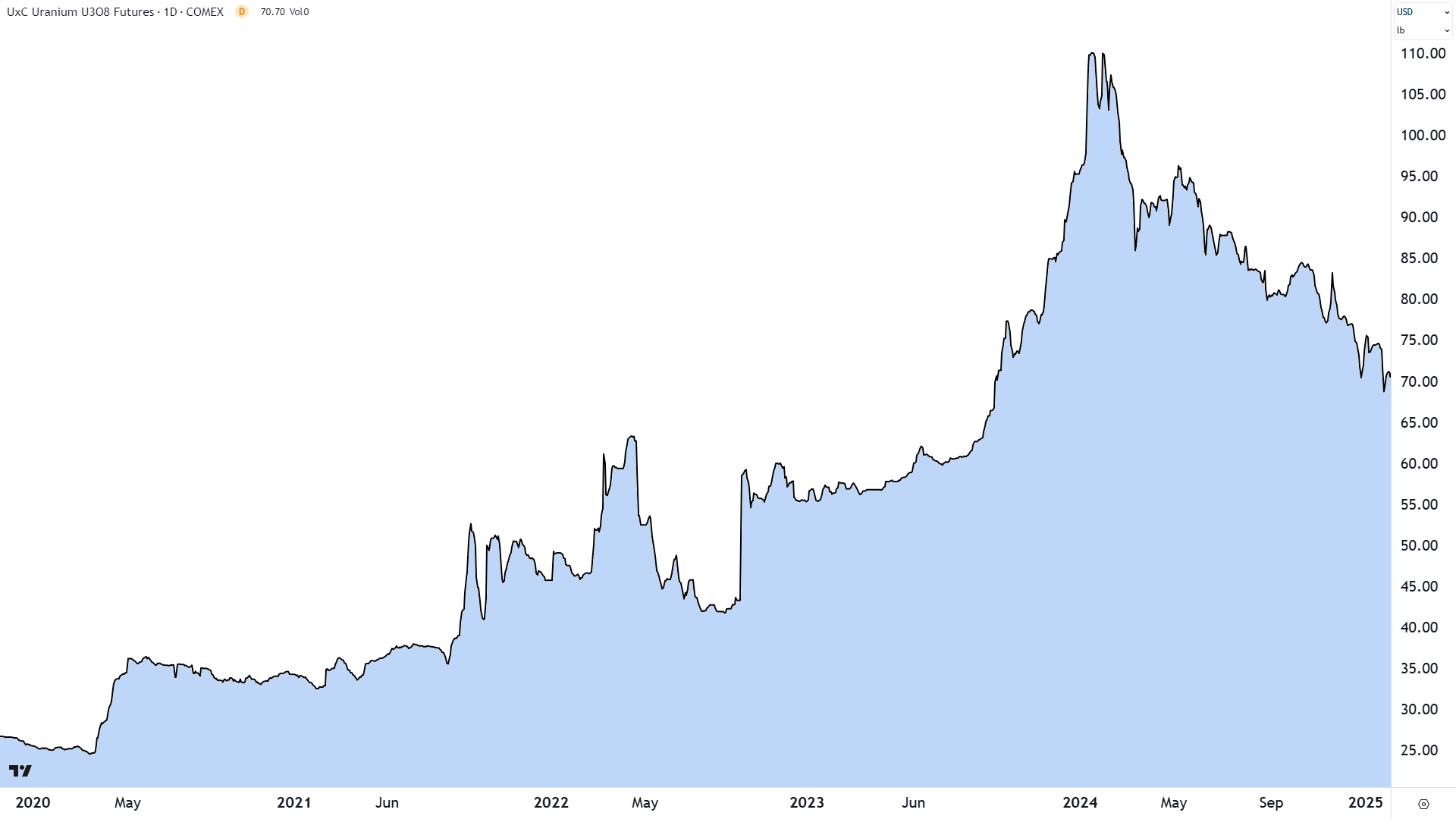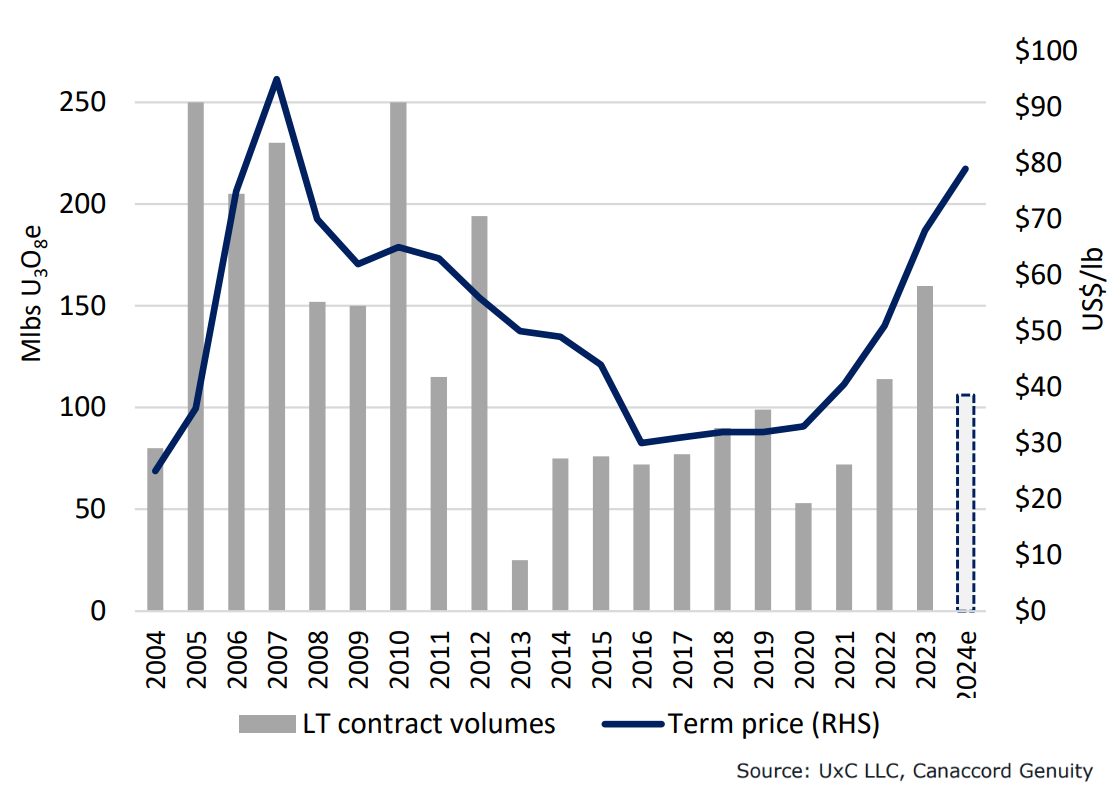What’s going on with the uranium market?
What’s going on with the uranium market? 🤔
This is the question many uranium investors, as well as investors peering in from the sidelines, are pondering. 2024 promised so much, but in the end and until the present, delivered very little.
The spot price of uranium reached a 17-year high of US$110/lb last January before retreating to just over US$68/lb last week. It’s bounced a little since then, now trading closer to US$71/lb. Still, when one considers this is roughly three times the price it started the current decade at, it’s not all bad.
%20COMEX%20since%202020.%20Source%20TradingView.png)
The fundamentals for the uranium price remain strong, according to diehard investors. One investor that is choosing to keep the faith is Canaccord Genuity. In a new research report released this week, they warn investors to stop watching the spot price – it’s just too short term. The term price is a far better indicator of what’s truly happening in the uranium market, the broker proposes, and it’s on the rise.
Let’s investigate the latest developments in the uranium market, including recent commodity price performance, demand-side factors such as nuclear energy production and AI and data center demand, as well as supply-side factors such as how difficult it’s proving for major producers to ramp up production.
Why 2024 was a year to forget for uranium
The volatility in uranium spot pricing last year was largely driven by financial speculators and short-term transactions, says Canaccord. Small trades – large price swings. The share prices of uranium equities around the world generally mirrored the downward trend in the spot market, as reflected by the 16% decline in the Global X Uranium ETF (ASX: ATOM, NYSE: URA).
Compare this result to the more stable term market where nuclear power utilities secure their long-term contracts. It was a case of a stable upward trajectory here, with utilities continuing to sign contracts at higher fixed prices with current floor-ceiling pricing around $75/lb - $120/lb. At the mid-point, the uranium term price rose 16% in 2024, and it’s trading at approximately an 8% premium to spot.

The fact of the matter is nuclear power utilities are thinking years and decades in advance, not about what’s happening on the day-to-day spot market. The upshot, according to Canaccord, is that uranium term price resilience has created an attractive entry point for investors, as most uranium equities are currently trading at a discount to long-term fundamental value.
Demand-side factors: Nuclear energy, AI, and Data Centres
There are two major demand side factors for investors to consider, proposes Canaccord:
There are currently 440 reactors in operation around the world, and global nuclear capacity is expanding, with 65 reactors currently under construction and around 100 more proposed or on the drawing board.
China remains the dominant player with respect to adding nuclear power capacity, with 28 reactors under construction and a long-term target of 200 GWe by 2035 (the current global nuclear power output is approximately 400 GWe or “Gigawatt electrical”). India is also ramping up its nuclear program, with ten reactors under development (7 GWe) and a strong policy push for expanded uranium procurement.
Reactors under construction represent roughly an 18% increase in capacity. Add in operating life extensions at existing reactors plus the restart of several idled reactors, and it appears the demand for uranium from nuclear power utilities appears to be both resilient and set to grow. Canaccord forecasts a compound annual growth rate (CAGR) in such demand of 3.6% p.a. through to 2035.
It’s worth also mentioning the increased energy consumption requirements of the burgeoning artificial intelligence (AI) industry as well as the explosion of data centre capacity to support it and other information technology industries. Data centres are projected to consume over 10% of U.S. electricity by 2030, with AI models requiring exponentially more power than traditional computing.
The best illustration of the perceived importance of AI as a driver of nuclear energy production came with last week’s market response to DeepSeek’s new large language model (LLM) application hitting top spot on Apple’s AppStore. DeepSeek’s creators claim it uses less energy intensive processing chips than contemporary AI applications – the result was instant and severe – a major sell off in global uranium stocks.
Many have since steadied as doubts have arisen surrounding the voracity of DeepSeek’s claims, but the connection between future global energy usage and the fortunes of uranium stocks is clear.
Looking forward, the IT industry has already thrown its hat in the ring, with tech giants such as Microsoft, Amazon, and Google forging partnerships with nuclear energy providers to secure stable, carbon-free baseload power.
Supply-side factors: The challenge of increasing supply
Bringing new uranium supply to market remains a significant challenge, suggests Canaccord. The broker notes that in 2024, several greenfield projects were delayed due to permitting, funding constraints, and technical setbacks. Combine these issues with the fact that the uranium spot price is approaching the widely cited “incentive price”, that is, the breakeven price for new projects, and the upshot is new mine developments have yet to materialise at scale.
Canaccord proposes the following structural issues will limit the ability of both development projects and major producers to ramp up uranium supply:
Geopolitical barriers
- The uranium market continues to be increasingly bifurcated by East-West tensions.
- The U.S. ban on Russian uranium imports and subsequent retaliatory export restrictions have tightened Western supply chains, driving up conversion and enrichment costs.
- Russia currently supplies 37% of global enrichment capacity, leaving Western utilities scrambling for alternative sources.
-
Labor and technical bottlenecks
Restarting idled mines and developing new projects requires specific technical expertise, much of which left the industry for other commodities in the near-decade-long bear market that followed the Fukushima powerplant disaster in 2011.
-
Permitting and financing challenges
- Regulatory hurdles and environmental concerns continue to delay new mine approvals, even projects that have secured funding, such as NexGen’s Rook I.
- Current development projects presently face multi-year construction timelines.
-
Delayed production ramp-ups
Key projects that are expected to contribute to supply over the next few years – such as Budenovskoye in Kazakhstan and Phoenix in Canada – have encountered setbacks, raising concerns about continued market deficits.
Conclusion: Narratives or price action?
It’s certainly a strong narrative:
Uranium’s bullish fundamentals remain intact despite 2024’s market turbulence. Spot price volatility is due merely to clouded investor sentiment and a few relatively small trades having an outsized impact in a thin market. Further, that term pricing trends underscore strong long-term demand – backed by nuclear energy’s resurgence and bottom-left-top-right AI power consumption.
On the supply-side, constraints ranging from permitting delays to geopolitical risks, continue to challenge industry efforts to scale production.
The result of these demand-supply factors will inevitably drive up the uranium price, and the share prices of undervalued uranium stocks.
If this strong narrative turns out to be the case, then it follows investors willing to navigate the current short-term volatility may find deep value opportunities. But that’s the thing about commodities investing – narratives sound good more often than not – and investors risk getting sucked in.
In my experience, it’s the price of the commodity that best reflects all available narratives, because it’s the indicator that best reflects actual demand and supply. I’m encouraged by the fact that the uranium term price continues to perform well, but I would prefer to see an upturn in the spot price, and in the share prices of uranium stocks, before calling the next leg up as begun.
Want to know more about Carl’s views on the uranium price? He conducts regular technical analysis on uranium and many other commodities such as iron ore, copper, gold, silver, crude oil and more each evening in the ChartWatch section of the Market Index Evening Wrap. Carl accurately called the upturn in the uranium price in 2023 as well as the downturn in early 2024, and has been bearish since. Stay tuned for when he finally calls the next leg up has begun!
This article first appeared on Market Index on Thursday 6 February 2025.
5 topics
20 stocks mentioned

